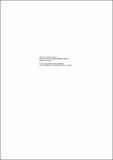| dc.contributor.author | Alibaruho, George | |
| dc.date.accessioned | 2011-04-07T12:49:29Z | |
| dc.date.available | 2011-04-07T12:49:29Z | |
| dc.date.issued | 1974-03 | |
| dc.identifier.citation | Alibaruho, George. (1974) The impact of marketing board policy on the level and variability of cotton producer prices in Uganda. Discussion Paper 199, Nairobi: Institute for Development Studies, University of Nairobi | en_GB |
| dc.identifier.uri | https://opendocs.ids.ac.uk/opendocs/handle/20.500.12413/562 | |
| dc.description.abstract | This paper seeks to examine the impact Marketing Board operation
has had on the level of cotton producer prices as well as the success
of marketing policy in stabilising these prices. A model of the
Ugandan cotton sector is presented in a relationship between a set of
endogenous policy target variables (i.e. interseasonal and intraseasonal
producer price variability) and a set of exogenous variables and
parameters (i.e. producer prices, ginners' allowance, export tax rates,
etc,) some subset of which are potential instruments of policy. Within
these relationships, we analyse the interrelatedness of unit export
revenue, ginners' allowance, ginners' prices as well as producer prices. We come to the conclusion that in the price determination exercise
performed by the Marketing Board, producer prices are a "residual"
itm. Furthermore, we analyse and quantify the extent to which the Marketing
Board has reduced the variability of producer prices, we conclude that
prior to 1965, the level of prices set was frequently inoptimal and this encouraged intraseasonal fluctuations. However, we find that the Board
has absorbed 15% of the total interseasonal instability, but because of the
residual nature of producer prices in the disposal of unit export revenue,
the price variable could not have been a "policy instrument" in the
models. Therefore, prices could not have been positively adjusted so as
to minimise their variability.
Export tax rates do not seem to have been varied for the purpose of
stabilising prices either. Considering that this tax is unjustifiable
from the point of view of world demand elasticity for Uganda cotton as well
as the fact that the tax is resource distortive, we are then left with only
one justification for this tax: a second-best solution to the government's
fiscal needs. Finally, we observe that the Board's administrative costs have
expanded out of proportion with the Board's level of operation due to
internal inefficiency and political pressure on the Board to expand
its bureaucracy as employer of "last resort". Nevertheless, we are led
to conclude that a neutral tax such as a land tax with less "announcement
effects" could be used to obtain xhe necessary fiscal revenue that might
then be deployed to employ people in more productive occupations than
marketing the cotton crop. | en_GB |
| dc.language.iso | en | en_GB |
| dc.publisher | Institute for Development Studies, University of Nairobi | en_GB |
| dc.relation.ispartofseries | Discussion Papers;199 | |
| dc.rights.uri | http://creativecommons.org/licenses/by-nc-nd/3.0/ | en_GB |
| dc.subject | Economic Development | en_GB |
| dc.title | The impact of marketing board policy on the level and variability of cotton producer prices in Uganda | en_GB |
| dc.type | Series paper (non-IDS) | en_GB |
| dc.rights.holder | Institute for Development Studies, University of Nairobi | en_GB |
| dc.identifier.blds | 317735 | |


